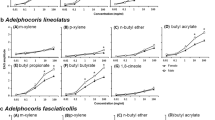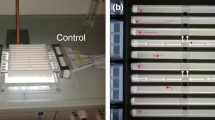Abstract
A semiochemical based push-pull strategy for control of oilseed rape pests is being developed at Rothamsted Research. This strategy uses insect and plant derived semiochemicals to manipulate pests and their natural enemies. An important element within this strategy is an understanding of the importance of non-host plant cues for pest insects and how such signals could be used to manipulate their behaviour. Previous studies using a range of non-host plants have shown that, for the pollen beetle Meligethes aeneus (Coleoptera: Nitidulidae), the essential oil of lavender, Lavandula angustifolia (Lamiaceae), was the most repellent. The aim of this study was to identify the active components in L. angustifolia oil, and to investigate the behaviour of M. aeneus to these chemicals, to establish the most effective use of repellent stimuli to disrupt colonisation of oilseed rape crops. Coupled gas chromatography-electroantennography (GC-EAG) and gas chromatography-mass spectrometry (GC-MS) resulted in the identification of seven active compounds which were tested for behavioural activity using a 4-way olfactometer. Repellent responses were observed with (±)-linalool and (±)-linalyl acetate. The use of these chemicals within a push-pull pest control strategy is discussed.


Similar content being viewed by others
References
Agelopoulos N, Birkett MA, Hick AJ, Hooper AM, Pickett JA, Pow EM, Smart LE, Smiley DWM, Wadhams LJ, Woodcock CM (1999) Exploiting semiochemicals in insect control. Pestic Sci 55:225–235
Al Abassi S, Birkett MA, Pettersson J, Pickett JA, Wadhams LJ, Woodcock CM (2000) Response of the seven-spot ladybird to an aphid alarm pheromone and an alarm pheromone inhibitor is mediated by paired olfactory cells. J Chem Ecol 26:1765–1771
Bernays EA, Chapman RF (1994) Host–plant selection by phytophagous insects. Chapman & Hall, New York
Blight MM, Smart LE (1999) Influence of visual cues and isothiocyanate lures on capture of the pollen beetle, Meligethes aeneus in field traps. J Chem Ecol 25:1501–1516
Blight MM, Pickett JA, Ryan J, Wadhams LJ, Woodcock CM (1995a) Recognition of oilseed rape volatiles by pollen beetles, Meligethes spp.: electrophysiological and chemical studies. In: Proceedings, GCIRC 9th international rapeseed congress 3, pp 1043–1045
Blight MM, Pickett JA, Wadhams LJ, Woodcock CM (1995b) Antennal perception of oilseed rape, Brassica napus (Brassicaceae), volatiles by the cabbage seed weevil Ceutorhynchus assimilis (Coleoptera: Curculionidae). J Chem Ecol 21:1649–1664
Bruce TJA, Martin JL, Pickett JA, Pye BJ, Smart LE, Wadhams LJ (2003) cis-Jasmone treatment induces resistance in wheat plants against the grain aphid, Sitobion avenae (Fabricius) (Homoptera: Aphididae) Pest Manage Sci 59:1031–1036
Bruce TJA, Wadhams LJ, Woodcock CM (2005). Insect host location: a volatile situation. Trends Plant Sci 10:269–274
Cardoza YJ, Alborn HT, Tumlinson JH (2002) In vivo volatile emissions from peanut plants induced by simultaneous fungal infection and insect damage. J Chem Ecol 28:161–174
Cook SM, Bartlet E, Murray DA, Williams IH (2002) The role of pollen odour in the attraction of pollen beetles to oilseed rape flowers. Entomol Exp Appl 104:43–50
Cook SM, Rasmussen HB, Birkett MA, Murray DA, Pye BJ, Watts NP, Williams IH (2007a) Behavioural and chemical ecology underlying the success of turnip rape (Brassica rapa) trap crops in protecting oilseed rape (Brassica napus) from the pollen beetle (Meligethes aeneus). Arthropod-Plant Interactions 1:57–67
Cook SM, Jönsson M, Skellern MP, Murray DA, Anderson P, Powell W (2007b) Responses of Phradis parasitoids to volatiles of lavender, Lavandula angustifolia – a possible repellent for their host, Meligethes aeneus. BioControl 52:591–598
Cook SM, Khan ZR, Pickett JA (2007c) The use of push-pull strategies in integrated pest management. Annu Rev Entomol 52:375–400
Couty A, Kaiser L, Huet D, Pham-Delegue MH (1999) The attractiveness of different odour sources from the fruit- host complex on Leptopilina boulardi, a larval parasitoid of frugivorous Drosophila spp. Physiol Entomol 24:76–82
Free JB, Williams IH (1978) The responses of the pollen beetle, Meligethes aeneus, and the seed weevil, Ceutorhynchus assimilis, to oilseed rape, Brassica napus and other plants. J Appl Ecol 15:761–774
Groot AT, Timmer R, Gort G, Lelyveld GP, Drijfhout FP, Van Beek TA, Visser JH (1999). Sex-related perception of insect and plant volatiles in Lygocoris pabulinus. J Chem Ecol 25:2357–2371
Hansen LM (2003) Insecticide-resistant pollen beetles (Meligethes aeneus F) found in Danish oilseed rape (Brassica napus L) fields. Pest Manage Sci 59:1057–1059
Henning JA, Teuber LR (1992) Combined gas-chromatography - electroantennogram characterization of alfalfa floral volatiles recognized by honey-bees (Hymenoptera, Apidae). J Econ Entomol 85:226–232
Henning JA, Peng YS, Montague MA, Teuber LR (1992) Honey-bee (Hymenoptera, Apidae) behavioral response to primary alfalfa (Rosales, Fabaceae) floral volatiles. J Econ Entomol 85:233–239
Isman MB (2006) Botanical insecticides, deterrents, and repellents in modern agriculture and an increasingly regulated world. Annu Rev Entomol 51:45–66
Koschier EH, Sedy KA (2003) Labiate essential oils affecting host selection and acceptance of Thrips tabaci Lindeman. Crop Prot 22:929–934
Maddrell SHP (1969) Secretion by the Malpighian tubules of Rhodnius. The movement of ions and water. J Exp Biol 51:71–97
Mauchline AL (2003) Behavioural and chemical ecology of Meligethes aeneus: Effects of non-host plant volatiles. PhD Thesis, The Open University
Mauchline AL, Osborne JL, Martin AP, Poppy GM, Powell W (2005) The effects of essential oil volatiles on the behaviour of the pollen beetle Meligethes aeneus. Entomol Exp Appl 114:181–188
Miller JR, Cowles RS (1990) Stimulo-deterrent diversion: a concept and its possible application to onion maggot control. J Chem Ecol 16:3197–3212
Omura H, Honda K, Hayashi N (2000) Floral scent of Osmanthus fragrans discourages foraging behaviour of cabbage butterfly, Pieris rapae. J Chem Ecol 26:655–666
Pettersson J (1970) An aphid sex attractant I. Biological studies. Entomol Scand 1:63–73
Pickett JA (1990) Gas chromatography-mass spectrometry in insect pheromone identification: three extreme cases. In: McCaffery AR, Wilson ID (eds) Chromatography and isolation of insect hormones and pheromones. Plenum Press, New York, pp 209–309
Pickett JA, Wadhams LJ, Woodcock CM (1997) Developing sustainable pest control from chemical ecology. Agric Ecosyst Environ 64:149–156
Pyke B, Rice M, Sabine G, Zalucki M (1987) The push-pull strategy – behavioural control of Heliothis. Australian Cotton Grower May–July
Ruther J, Thiemann K (1997) Response of the pollen beetle Meligethes aeneus to volatiles emitted by intact plants and conspecifics. Entomol Exp Appl 84:183–188
Smart LE, Blight MM (2000) Response of the pollen beetle, Meligethes aeneus, to traps baited with volatiles from oilseed rape, Brassica napus. J Chem Ecol 26:1051–1064
Smart LE, Blight MM, Hick AJ (1993) Development of a monitoring system for the cabbage seed weevil and the pollen beetle. IOBC/WPRS Bull 16:351–354
Smart LE, Blight MM, Ryan J (1995) Response of pollen beetles, Meligethes spp., to volatiles from Brassica napus. In: Proceedings 9th international rapeseed congress, pp 122–124
Vet LEM, van Lenteren JC, Heymans M, Meelis E (1983) An air-flow olfactometer for measuring olfactory responses of hymenopterous parasitoids and other small insects. Physiol Entomol 8:97–106
Wadhams LJ (1990) The use of coupled gas chromatography: electrophysiological techniques in the identification of insect pheromones. In: McCaffery AR, Wilson ID (eds) Chromatography and isolation of insect hormones and pheromones. Plenum Press, New York, pp 289–298
Wadhams LJ, Angst ME, Blight MM (1982) Responses of the olfactory receptors of Scolytus scolytus (F.) (Coleoptera: Scolytidae) to the stereoisomers of 4-methyl-3-heptanol. J Chem Ecol 8:477–492
Winfield AL (1992) Management of oilseed rape pests in Europe. Agric Zool Rev 5:51–94
Acknowledgements
The authors would like to thank Keith Chamberlain for assistance with gas chromatography, Ray Marriott from Botanix for supplying the lavender essential oil and Sam Cook for useful discussions and encouragement. This work was funded by the UK Department for Environment, Food and Rural Affairs. Rothamsted Research receives grant-aided support from the Biotechnology and Biological Sciences Research Council (BBSRC) of the UK.
Author information
Authors and Affiliations
Corresponding author
Additional information
Handling Editor: Yvan Rahbe.
Rights and permissions
About this article
Cite this article
Mauchline, A.L., Birkett, M.A., Woodcock, C.M. et al. Electrophysiological and behavioural responses of the pollen beetle, Meligethes aeneus, to volatiles from a non-host plant, lavender, Lavandula angustifolia (Lamiaceae). Arthropod-Plant Interactions 2, 109–115 (2008). https://doi.org/10.1007/s11829-008-9038-3
Received:
Accepted:
Published:
Issue Date:
DOI: https://doi.org/10.1007/s11829-008-9038-3




